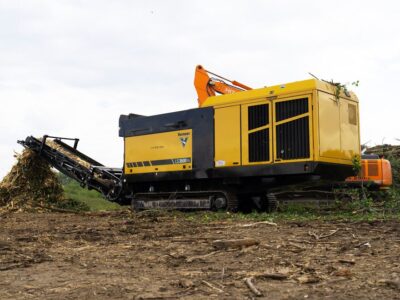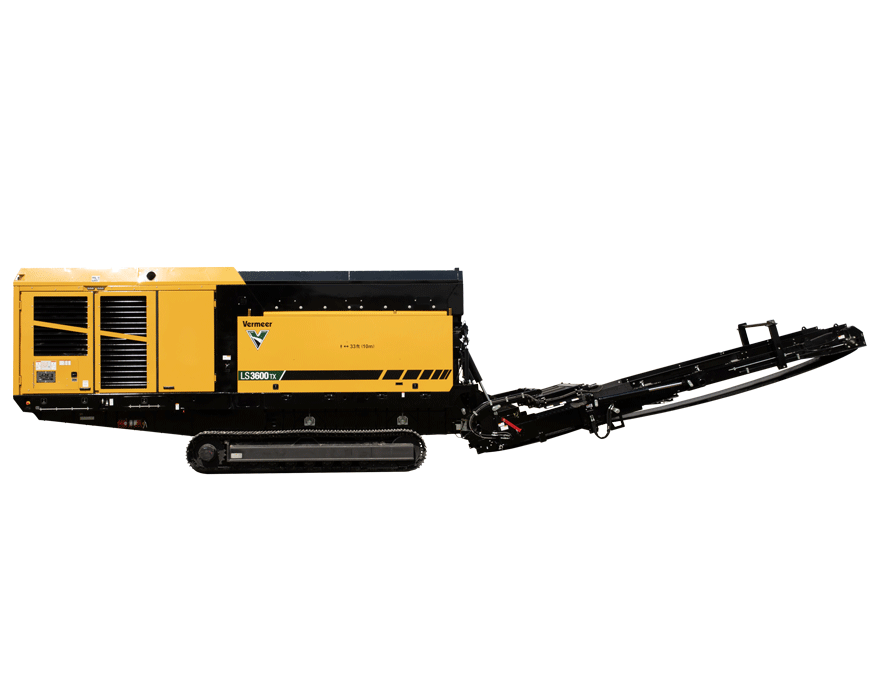Natural disasters leave communities with overwhelming amounts of debris that need to be processed efficiently. Large volumes of mixed materials — including wood, building materials and household debris — can complicate cleanup efforts. Efficient processing helps accelerate recovery and supports recycling efforts.
Ted Dirkx, sales manager for Vermeer environmental equipment, explained how the Vermeer LS3600TX low speed shredder helps streamline cleanup efforts and improve material processing in the conversation below.
How does the Vermeer LS3600TX assist in disaster recovery efforts?
The key advantage of the LS3600TX is its ability to handle co-mingled materials. After a storm, debris is often a mix of wood, building materials and other waste that can be difficult to separate. High speed grinders struggle with mixed materials containing metal contaminants, whereas low speed shredders manage these more effectively. This allows contractors to manage debris faster and more efficiently.
How do different Vermeer waste processing machines help with disaster cleanup?
Each piece of equipment has a specific role in cleanup operations. The LS3600TX is best for processing co-mingled construction and demolition (C&D) debris. Horizontal grinders and tub grinders provide a more efficient solution for clean green waste. When debris consists mostly of tree waste without contaminants, high-speed grinders are the preferred option.
What are the main benefits of using a low speed shredder for disaster cleanup?
There are significant advantages to using a low speed shredder for disaster cleanup. First, it addresses a major logistical challenge: transportation. Raw debris is bulky and full of air space, making it inefficient to haul. Shredding compacts the material, allowing more to be transported per load, which helps reduce costs and speeds up cleanup efforts.
Additionally, for landfills, maximizing available space is critical. Pre-shredding debris improves compaction, helping to make disposal more efficient and cost-effective. This is also because shredding the material reduces large air gaps found in typical storm debris, helping to extend the landfill’s lifespan.
What should operators keep in mind when feeding material into the LS3600TX?
Operators should look for and remove materials that could damage the machine, such as large concrete blocks, stoops, boulders, large pieces of iron, lawn equipment, appliances, root balls and toxic materials. While the LS3600TX has built-in protections to handle small unshreddable objects, careful sorting can help extend machine life and maintain efficiency.
Are contractors more interested in using shredders for disaster cleanup?
Yes, many contractors are starting to see shredders as a key part of their storm cleanup process. Shredders weren’t commonly used for disaster recovery in the past, but as storms become more frequent and severe, efficiency is becoming a top priority.
How is the increasing frequency of severe storms affecting cleanup operations?
According to the U.S. Environmental Protection Agency (EPA), the frequency and intensity of extreme weather events have increased, leading to a greater need for efficient disaster cleanup solutions. As storms become more frequent and severe, speed and efficiency in cleanup operations are critical. The LS3600TX helps by allowing more material to be processed per load, improving transport efficiency and enabling contractors to complete jobs faster. This is essential in responding to the growing number of storm events and helping communities recover quickly.
What types of materials typically need to be processed in disaster cleanup?
According to the EPA, natural disasters generate significant amounts of debris, including vegetative material, construction and demolition waste, household items and hazardous materials that must be managed appropriately. Storm-damaged areas contain a mix of materials, including wood waste from destroyed structures, household debris, plumbing, electrical components and various building materials like flooring and wallboard. Non-permitted materials and appliances must be sorted separately before processing begins to ensure proper disposal and recycling.
Why is equipment like the LS3600TX becoming more important in extreme weather events?
According to the Federal Emergency Management Agency (FEMA), delays in disaster recovery can lead to prolonged economic hardship, infrastructure failures and health risks for affected communities. Fast recovery is crucial after a natural disaster, as prolonged disrepair makes rebuilding efforts more challenging. The LS3600TX allows contractors to process debris quickly, making a significant impact on how fast communities can rebuild. In a recent tornado cleanup, crews were nearing the end of the primary debris processing stage just two weeks after the storm hit. That kind of efficiency is critical to getting communities back to normal as soon as possible.
LS3600TX for disaster recovery
The LS3600TX low speed shredder helps with disaster recovery by efficiently processing storm debris, improving material handling and helping to reduce transportation costs.
Key product features:
1. Robust shredding system – Handles a mix of contaminated and non-contaminated debris, including construction and demolition waste.
2. Compact and mobile design – Easily transported to disaster zones, allowing for onsite debris processing.
3. Efficient material reduction – Reduces the bulk of debris, improving haul-away efficiency and landfill management.
How to buy a low speed shredder
Disaster recovery requires the right equipment to get the job done efficiently. The LS3600TX is designed to help contractors manage debris more effectively, minimize costs and support faster cleanup efforts. Learn more about how this machine can benefit your operation by contacting your local Vermeer dealer.
Vermeer Corporation reserves the right to make changes in engineering, design and specifications; add improvements; or discontinue manufacturing at any time without notice or obligation. Equipment shown is for illustrative purposes only and may display optional accessories or components specific to their global region. Please contact your local Vermeer dealer for more information on machine specifications. Vermeer and the Vermeer logo are trademarks of Vermeer Manufacturing Company in the U.S. and/or other countries.
© 2025 Vermeer Corporation. All Rights Reserved.

